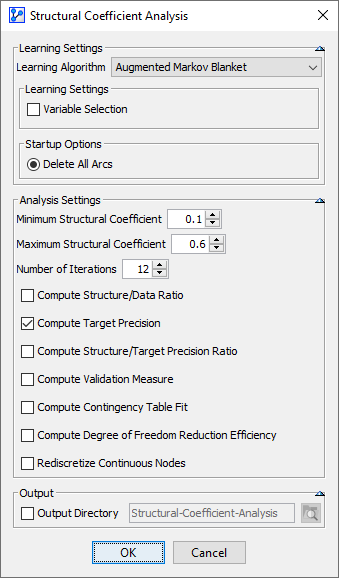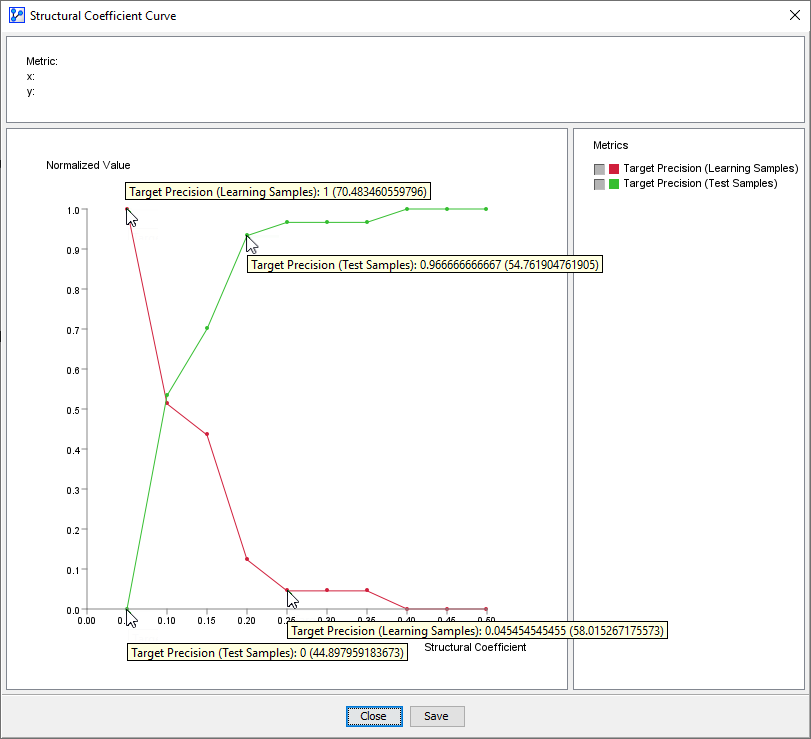Target Precision
Context
- The Target Precision is one of the measures that can be computed in the Structural Coefficient Analysis and plotted in the Curve window.
- When plotted, the Target Precision can help you determine an appropriate value for the Structural Coefficient given your dataset and the learning algorithm you selected.
- The Target Precision metric is intended to be used primarily in the context of Supervised Learning.
Usage
- To illustrate the Target Precision metric, we use a sample network that predicts contraceptive use of married Indonesian women as a function of demographic attributes. This model is based on a subset of variables from the 1987 National Indonesia Contraceptive Prevalence Survey, which is available from the UCI Machine Learning Repository .
-
Now, we perform a Structural Coefficient Analysis:
Main Menu > Tools > Multi-Run > Structural Coefficient Analysis. -
We follow the overall workflow introduced in Structural Coefficient Analysis.
-
Given that this is a predictive model, we select a Supervised Learning algorithm from the settings window.
-
More specifically, we choose the Augmented Markov Blanket and examine a range of 0.05 and 0.5 for the Structural Coefficient in 10 iterations.
-
In the context of a predictive model, the Target Precision is one of the key metrics to evaluate.

-
The dataset associated with this model is split into a Learning Set and a Test Set, as indicated by the symbol tagged onto the database icon in the lower right-hand corner of the Graph Window.
-
Given the split, the Structural Coefficient Analysis calculates the Target Precision separately for the Learning Set and the Test Set.

-
Note that the y-axis is normalized, but you can view the absolute values by hovering over individual points. The values in parentheses are the non-normalized values of Target Precision.
-
In general, reducing the Structural Coefficient (x-axis) increases the Target Precision (y-axis) for the Learning Samples (red curve).
-
Hence, it is always tempting to decrease the Structural Coefficient in pursuit of higher predictive performance.
-
And, for SC>0.25, Target Precision (Learning Samples) appears relatively flat.
-
For , the Target Precision (Learning Samples) increases very rapidly, potentially suggesting a good predictive performance. However, the performance of the model with regard to the learning set is of little value if it doesn’t hold up in out-of-sample testing.
-
And, indeed, the performance for does not hold up for the Test Set (green curve).
-
While, for SC>0.25, Target Precision (Test Samples) appears flat, too, for , Target Precision (Test Samples) decreases very rapidly.
-
In absolute terms, at SC=0.05, the Target Precision (Learning Samples) of 70% is vastly different from the Target Precision (Test Samples) of 45%. This is a very clear sign of overfitting.
-
So, learning with an extremely low value of SC=0.05 would clearly lead to a model that cannot generalize beyond the learning sample.
-
As a result, we can use the two curves as an additional visual guide for staying clear of potential overfitting.
-
Note that this is not a hard-and-fast rule. Rather, you should use this Target Precision plot in the context of all the other available plots.
